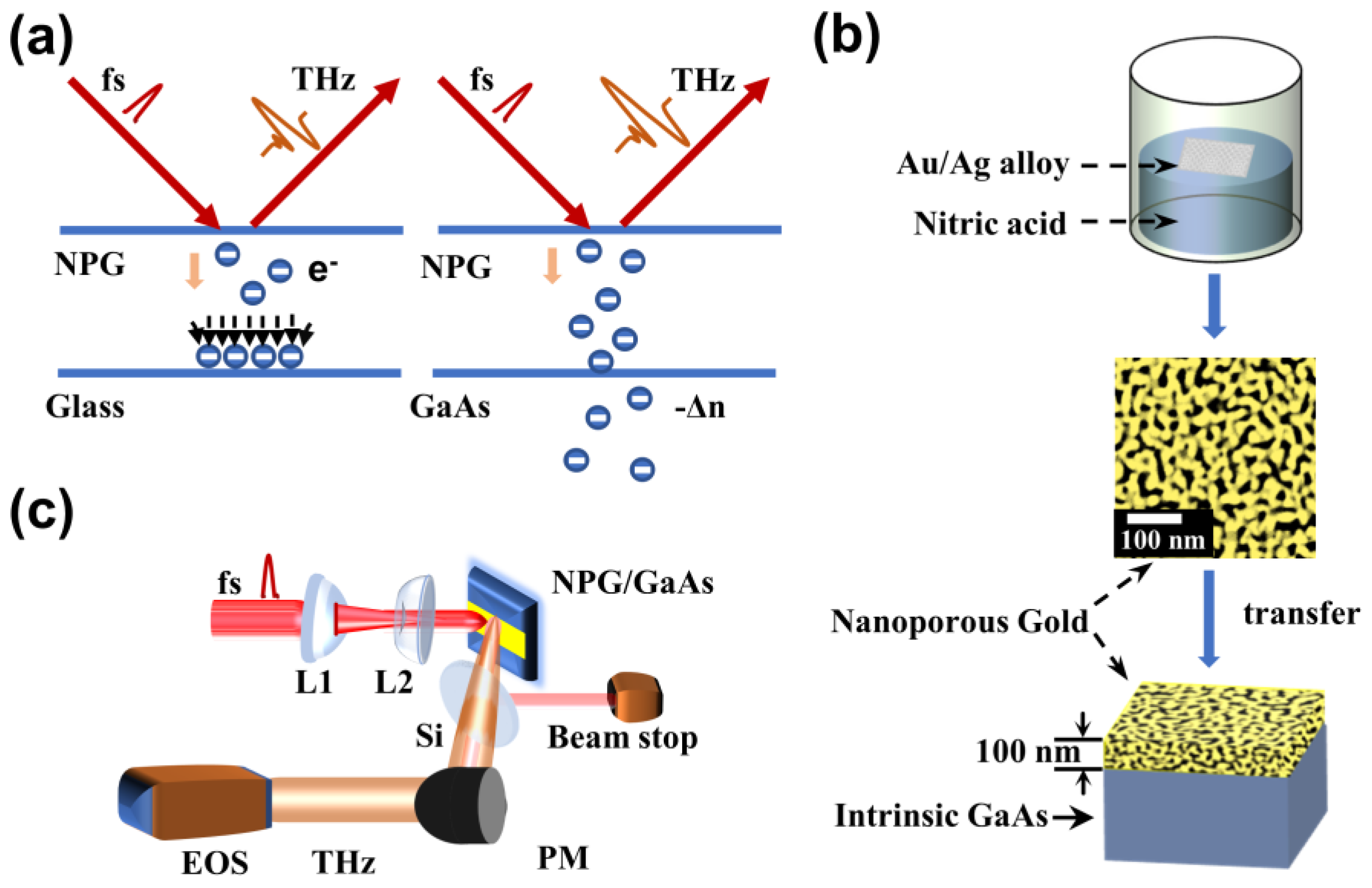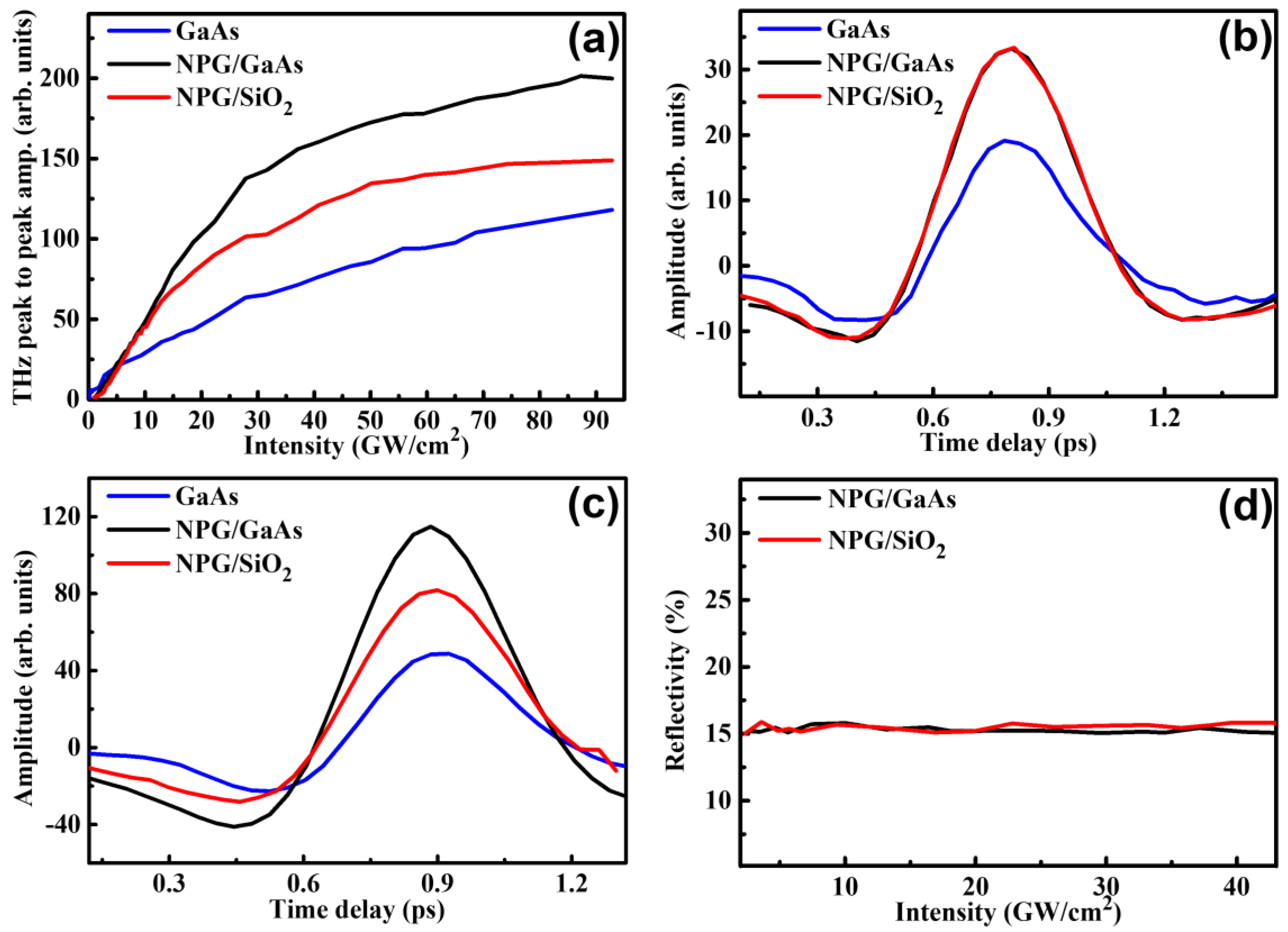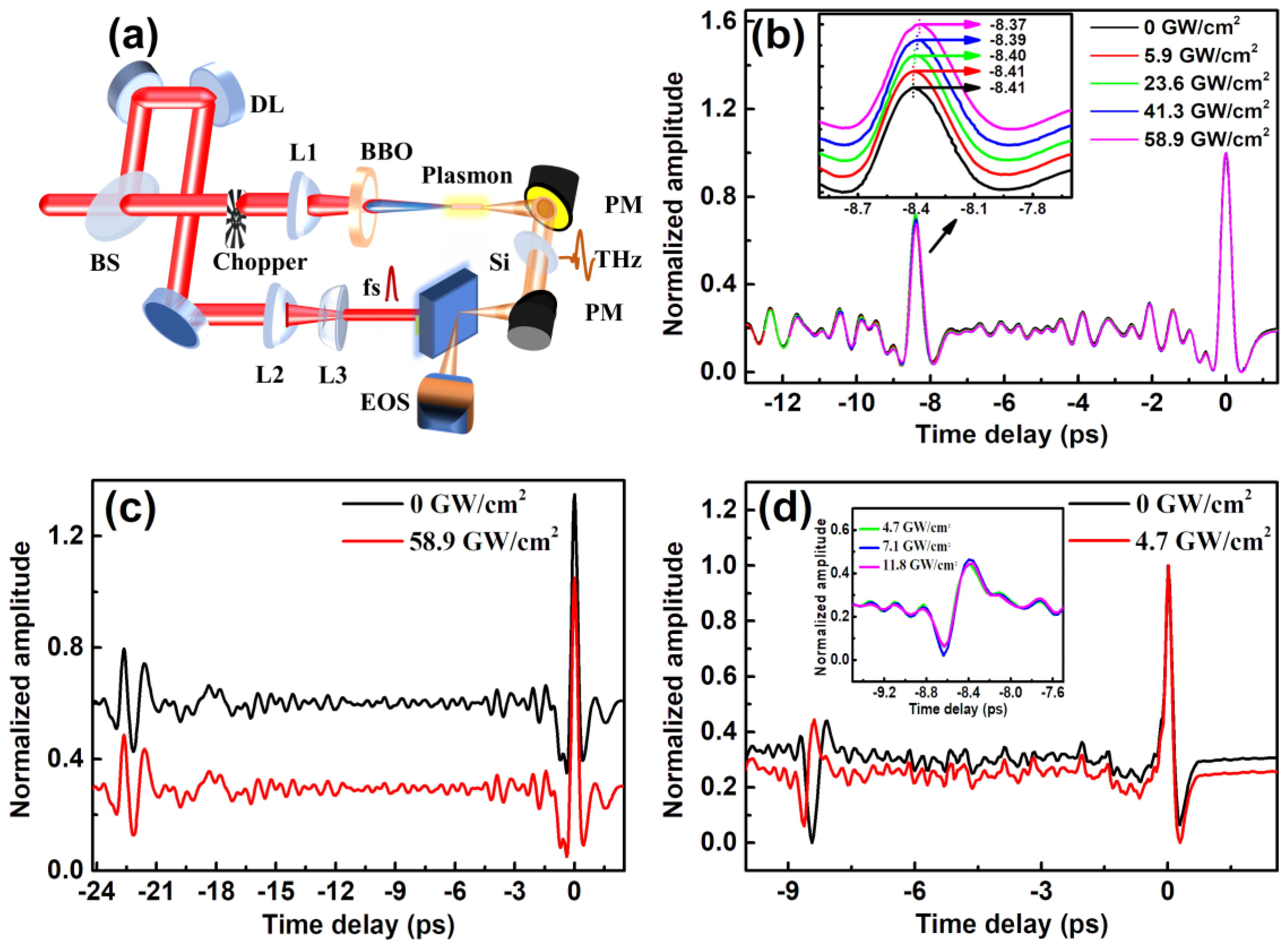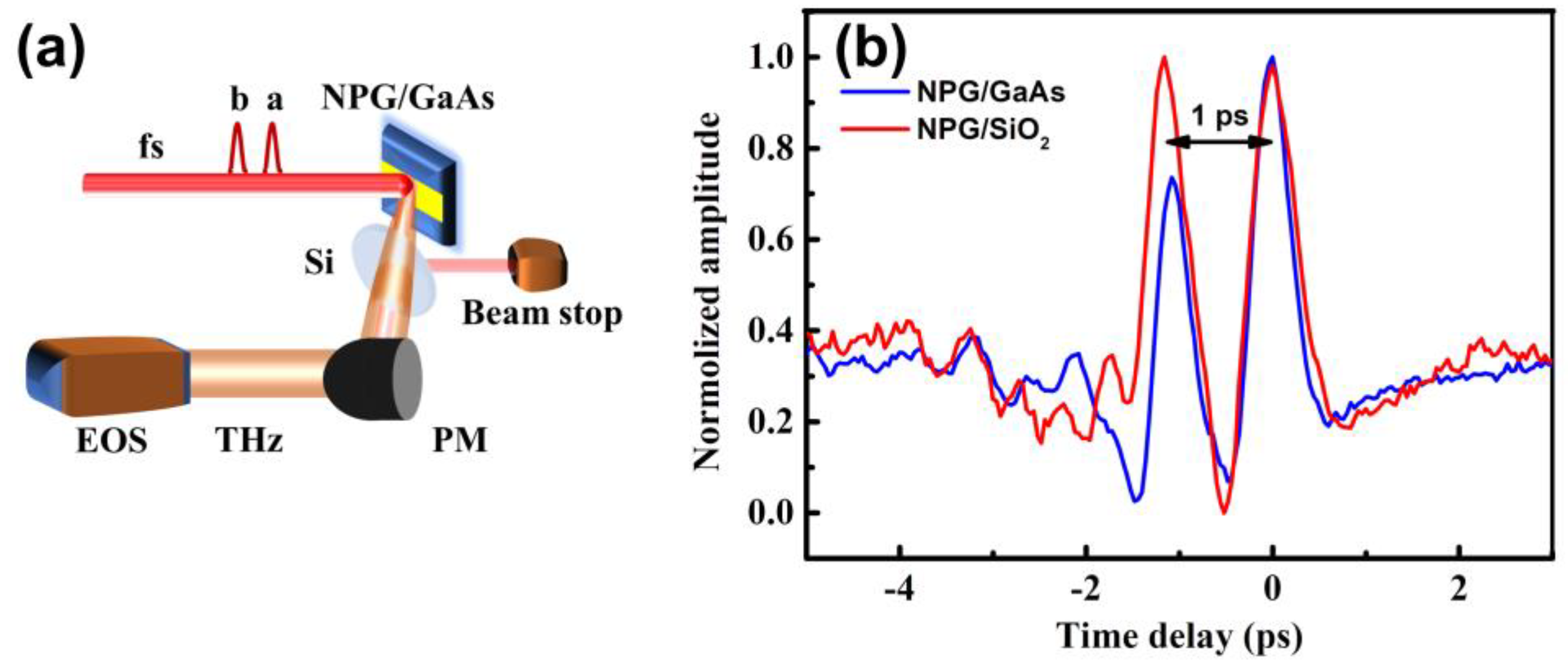Terahertz and Photoelectron Emission from Nanoporous Gold Films on Semiconductors
Abstract
1. Introduction
2. Materials and Methods
3. Results and discussion
4. Conclusions
Author Contributions
Funding
Conflicts of Interest
References
- Tian, Y.; Liu, J.S.; Bai, Y.F.; Zhou, S.Y.; Sun, H.Y.; Liu, W.W.; Zhao, J.Y.; Li, R.X.; Xu, Z.Z. Femtosecond-laser-driven wire-guided helical undulator for intense terahertz radiation. Nat. Photonics 2017, 11, 242–246. [Google Scholar] [CrossRef]
- Dey, I.; Jana, K.; Fedorov, V.Y.; Koulouklidis, A.D.; Mondal, A.; Shaikh, M.; Sarkar, D.; Lad, A.D.; Tzortzakis, S.; Couairon, A.; et al. Highly efficient broadband terahertz generation from ultrashort laser filamentation in liquids. Nat. Commun. 2017, 8, 1184. [Google Scholar] [CrossRef] [PubMed]
- Huang, H.; Nagashima, T.; Hsu, W.H.; Juodkazis, S.; Hatanaka, K. Dual THz wave and X-ray generation from a water film under femtosecond laser excitation. Nanomaterials 2018, 8, 523. [Google Scholar] [CrossRef] [PubMed]
- Thomson, M.D.; Kress, M.; Loffler, T.; Roskos, H.G. Broadband THz emission from gas plasmas induced by femtosecond optical pulses: From fundamentals to applications. Laser Photon. Rev. 2007, 1, 349–368. [Google Scholar]
- Zhang, L.L.; Mu, K.J.; Zhou, Y.S.; Wang, H.; Zhang, C.L.; Zhang, X.C. High-power THz to IR emission by femtosecond laser irradiation of random 2D metallic nanostructures. Sci. Rep. 2015, 5, 12536. [Google Scholar] [CrossRef] [PubMed]
- Ramakrishnan, G.; Kumar, N.; Ramanandan, G.K.P.; Adam, A.J.L.; Hendrikx, R.W.A.; Planken, P.C.M. Plasmon-enhanced terahertz emission from a semiconductor/metal interface. Appl. Phys. Lett. 2014, 104, 071104. [Google Scholar] [CrossRef]
- Ramakrishnan, G.; Ramanandan, G.K.P.; Adam, A.J.L.; Xu, M.; Kumar, N.; Hendrikx, R.W.A.; Planken, P.C.M. Enhanced terahertz emission by coherent optical absorption in ultrathin semiconductor films on metals. Opt. Express 2013, 21, 16784–16798. [Google Scholar] [CrossRef]
- Wang, K.L.; Mittleman, D.M. Metal wires for terahertz wave guiding. Nature 2004, 432, 376–379. [Google Scholar] [CrossRef]
- Zhu, J.F.; Ma, Z.F.; Sun, W.J.; Ding, F.; He, Q.; Zhou, L.; Ma, Y.G. Ultra-broadband terahertz metamaterial absorber. Appl. Phys. Lett. 2014, 105, 021102. [Google Scholar] [CrossRef]
- Hilton, D.J.; Averitt, R.D.; Meserole, C.A.; Fisher, G.L.; Funk, D.J.; Thompson, J.D.; Taylor, A.J. Terahertz emission via ultrashort-pulse excitation of magnetic metal films. Opt. Lett. 2004, 29, 1805–1807. [Google Scholar] [CrossRef]
- Kadlec, F.; Kuzel, P.; Coutaz, J.L. Optical rectification at metal surfaces. Opt. Lett. 2004, 29, 2674–2676. [Google Scholar] [CrossRef]
- Kadlec, F.; Kuzel, P.; Coutaz, J.L. Study of terahertz radiation generated by optical rectification on thin gold films. Opt. Lett. 2005, 30, 1402–1404. [Google Scholar] [CrossRef] [PubMed]
- Welsh, G.H.; Hunt, N.T.; Wynne, K. Terahertz-pulse emission through laser excitation of surface plasmons in a metal grating. Phys. Rev. Lett. 2007, 98, 026803. [Google Scholar] [CrossRef]
- Luo, L.; Chatzakis, I.; Wang, J.G.; Niesler, F.B.P.; Wegener, M.; Koschny, T.; Soukoulis, C.M. Broadband terahertz generation from metamaterials. Nat. Commun. 2014, 5, 3055. [Google Scholar] [CrossRef]
- Zhang, L.; Song, Y.K.; Fujita, T.; Zhang, Y.; Chen, M.W.; Wang, T.H. Large enhancement of quantum dot fluorescence by highly scalable nanoporous gold. Adv. Mater. 2014, 26, 1289–1294. [Google Scholar] [CrossRef] [PubMed]
- Aeschlimann, M.; Schmuttenmaer, C.A.; Elsayed-Ali, H.E.; Miller, R.J.D.; Cao, J.; Gao, Y.; Mantell, D.A. Observation of surface enhanced multiphoton photoemission from metal surfaces in the short pulse limit. J. Chem. Phys. 1995, 102, 8606–8613. [Google Scholar] [CrossRef]
- Dorney, T.D.; Mittleman, D.M.; Baraniuk, R.G. Material parameter estimation with terahertz time-domain spectroscopy. J. Opt. Soc. Am. A 2001, 18, 1562–1571. [Google Scholar] [CrossRef]
- Kim, C.; Wu, D.H.; Graber, B. GaAs refractive index dependence on carrier density and optimizing terahertz devices. In Proceedings of the American Physical Society Meeting, Baltimore, MD, USA, March 2016. [Google Scholar]
- Stern, F. Dispersion of the Index of Refraction Near the Absorption Edge of Semiconductors. Phys. Rev. 1964, 133, A1653. [Google Scholar] [CrossRef]
- Tarucha, S.; Kobayashi, H.; Horikoshi, Y.; Okamoto, H. Carrier-induced energy-gap shrinkage in current-injection GaAs/AlGaAs MQW heterostructures. Jpn. J. Appl. Phys. 1984, 23, 874–878. [Google Scholar] [CrossRef]
- Henry, C.H.; Logan, R.A.; Bertness, K.A. Spectral dependence of the change in refractive index due to carrier injection in GaAs lasers. J. Appl. Phys. 1981, 52, 4457–4461. [Google Scholar] [CrossRef]
- Bennett, B.R.; Soref, R.A.; Del Alamo, J.A. Carrier-induced change in refractive index of InP, GaAs and InGaAsP. IEEE J. Quantum Elect. 1990, 26, 113–122. [Google Scholar] [CrossRef]
- Couairon, A.; Mysyrowicz, A. Femtosecond filamentation in transparent media. Phys. Rep. 2007, 441, 47–189. [Google Scholar] [CrossRef]
- He, B.Q.; Nan, J.Y.; Li, M.; Yuan, S.; Zeng, H.P. Terahertz modulation induced by filament interaction. Opt. Lett. 2017, 42, 967–970. [Google Scholar] [CrossRef] [PubMed]
- Li, M.; Pan, H.F.; Tong, Y.Q.; Chen, C.; Shi, Y.; Wu, J.; Zeng, H.P. All-optical ultrafast polarization switching of terahertz radiation by impulsive molecular alignment. Opt. Lett. 2011, 36, 3633–3635. [Google Scholar] [CrossRef] [PubMed]
- Hussain, B.; Ahmed, M.; Nawaz, M.; Saleem, M.; Razzaq, M.; Zia, M.A.; Iqbal, M. Simultaneous determination of thickness and refractive index based on time-of-flight measurement of terahertz pulse. Appl. Opt. 2012, 51, 5326–5330. [Google Scholar] [CrossRef] [PubMed]
- Mendoza-Alvarez, J.G.; Nunes, F.D.; Patel, N.B. Refractive index dependence on free carriers for GaAs. J. Appl. Phys. 1980, 51, 4365–4367. [Google Scholar] [CrossRef]
- Sell, D.D.; Casey, H.C.; Wecht, K.W. Concentration dependence of the refractive index for n- and p-type GaAs between 1.2 and 1.8 eV. J. Appl. Phys. 1974, 45, 2650–2657. [Google Scholar] [CrossRef]




© 2019 by the authors. Licensee MDPI, Basel, Switzerland. This article is an open access article distributed under the terms and conditions of the Creative Commons Attribution (CC BY) license (http://creativecommons.org/licenses/by/4.0/).
Share and Cite
Nan, J.; Li, M.; Zhang, L.; Yuan, S.; He, B.; Zeng, H. Terahertz and Photoelectron Emission from Nanoporous Gold Films on Semiconductors. Nanomaterials 2019, 9, 419. https://doi.org/10.3390/nano9030419
Nan J, Li M, Zhang L, Yuan S, He B, Zeng H. Terahertz and Photoelectron Emission from Nanoporous Gold Films on Semiconductors. Nanomaterials. 2019; 9(3):419. https://doi.org/10.3390/nano9030419
Chicago/Turabian StyleNan, Junyi, Min Li, Ling Zhang, Shuai Yuan, Boqu He, and Heping Zeng. 2019. "Terahertz and Photoelectron Emission from Nanoporous Gold Films on Semiconductors" Nanomaterials 9, no. 3: 419. https://doi.org/10.3390/nano9030419
APA StyleNan, J., Li, M., Zhang, L., Yuan, S., He, B., & Zeng, H. (2019). Terahertz and Photoelectron Emission from Nanoporous Gold Films on Semiconductors. Nanomaterials, 9(3), 419. https://doi.org/10.3390/nano9030419






